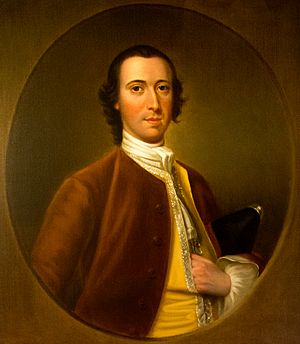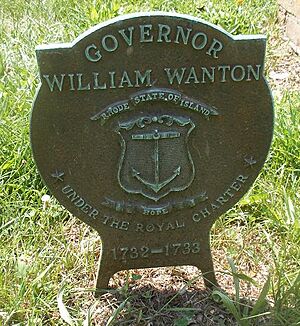William Wanton facts for kids
Quick facts for kids
William Wanton
|
|
|---|---|

Official portrait in the Rhode Island State House
|
|
| 20th Governor of the Colony of Rhode Island and Providence Plantations | |
| In office 1732–1733 |
|
| Preceded by | Joseph Jenckes |
| Succeeded by | John Wanton |
| Personal details | |
| Born | September 15, 1670 Scituate, Massachusetts |
| Died | December 1733 (aged 63) Newport, Rhode Island |
| Resting place | Clifton Burying Ground, Newport |
| Spouses | Ruth Bryant Mary Godfrey |
| Occupation | Assistant, Deputy, Colonel of militia, Speaker of House of Deputies, Governor |
William Wanton (born September 15, 1670 – died December 1733) was an important leader in the early Rhode Island colony. He served as governor for a short time before he passed away. William Wanton spent most of his life working for his community. He was involved in both government and military roles. He even commanded a special boat called a sloop to chase after privateers, who were like legal pirates.
Contents
Early Life and Beliefs
William Wanton was the third son of Edward Wanton, who built ships. William became a Quaker, a religious group known for its peaceful beliefs. He also became a Quaker preacher. His father had lived in different places like York, Maine and Boston, Massachusetts, before settling in Rhode Island.
Public Service and Military Roles
William Wanton was a successful merchant. In 1698, he became a "freeman" of Newport. This meant he had the right to vote and hold public office. After this, he became very active in the government and military of Rhode Island.
Working in Government
For almost every year between 1705 and 1732, William Wanton was either a "deputy" or an "assistant." These were important roles in the colony's government. A deputy was like a representative, and an assistant helped the governor. For many of these years, he was also the Speaker of the House of Deputies. This meant he led the meetings of the colony's main law-making group.
Leading the Military
William Wanton also had a strong military career. From 1705 to 1710, he was the "Major for the Islands." This put him in charge of the local soldiers, called militia, on several islands like Aquidneck and Block Island. Later, from 1719 to 1731, he was a "colonel." This made him the leader of the "Militia of the Islands" regiment, a larger group of soldiers.
Wanton also commanded a sloop, which is a type of sailboat. He used it to chase after privateers. These were private ships allowed by the government to attack enemy ships during wartime. In 1709, the government even bought his new sloop, named Diamond, to help protect the colony.
In 1726, William Wanton was chosen as one of four leaders from Rhode Island. Their job was to meet with leaders from Connecticut to figure out the exact border between the two colonies.
William Wanton was elected governor of the Rhode Island colony in 1732. He served one full term. He passed away during his second term in office, sometime between December 1733 and February 1734. He was buried in the Clifton Burying Ground in Newport.
Family Life
William Wanton was married twice. His first wife was Ruth Bryant. They had nine children together. In 1717, when he was 46, he married Mary Godfrey. She was 15 years old and the granddaughter of another governor, Caleb Carr. They did not have any children together. After William Wanton's death, his widow Mary married Daniel Updike in 1745.
William Wanton's family was very involved in Rhode Island's government.
- His brother, John Wanton, became governor right after him.
- His nephew, Gideon Wanton, also became governor later on.
- His son, Joseph Wanton, was governor when the American Revolutionary War began. However, he was removed from office because he had loyalist sympathies, meaning he supported the British King.


